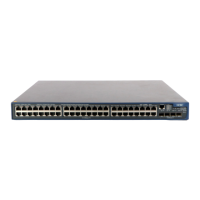1-28
Examples
# Set the 802.1p priority to 1 for the packets received on any ports in VLAN 2 and destined to MAC
address 000F-E200-1234.
<Sysname> system-view
System View: return to User View with Ctrl+Z.
[Sysname] acl number 4000
[Sysname-acl-ethernetframe-4000] rule permit cos 3 dest 000f-e200-1234 ffff-ffff-ffff
[Sysname-acl-ethernetframe-4000] quit
[Sysname] traffic-priority vlan 2 inbound link-group 4000 cos 1
traffic-redirect
Syntax
traffic-redirect { inbound | outbound } acl-rule { cpu | { interface interface-type interface-number |
link-aggregation-group agg-id } [ untagged ] }
undo traffic-redirect { inbound | outbound } acl-rule
View
Ethernet port view
Parameters
inbound: Redirects inbound packets.
outbound: Redirects outbound packets.
acl-rule: ACL rules to be applied for traffic classification. This argument can be the combination of
multiple ACLs. For more information about this argument, refer to
Table 1-4 and Table 1-5. Note that the
ACL rules referenced must be those defined with the permit keyword.
cpu: Redirects the packets to the CPU.
interface interface-type interface-number: Specifies the target port, to which the packets are to be
redirected. The interface-type interface-number argument refers to the port type and port number.
link-aggregation-group agg-id: Specifies the aggregation group the traffic is to be redirected to. The
agg-id argument is the ID of an aggregation group, in the range 1 to 416.
untagged: Specifies to remove the outer VLAN tag of a packet after the packet is redirected to a port or
an aggregation group.
Description
Use the traffic-redirect command to configure traffic redirecting on a port.
Use the undo traffic-redirect command to remove the configuration from the port.
You can configure to redirect inbound or outbound packets matching a specified ACL rule on a port to
the CPU, the specified port, or the specified aggregation group.
Related commands: display qos-interface traffic-redirect.

